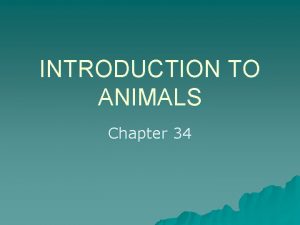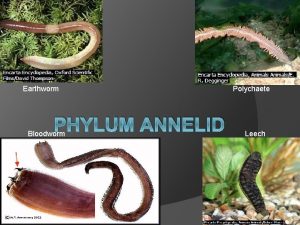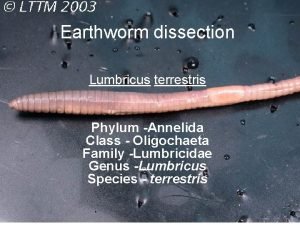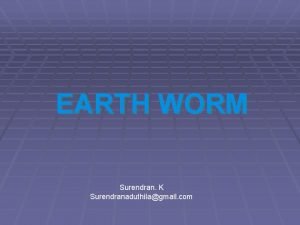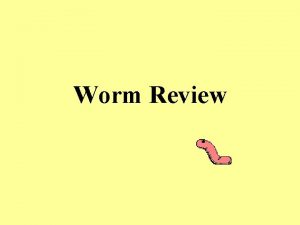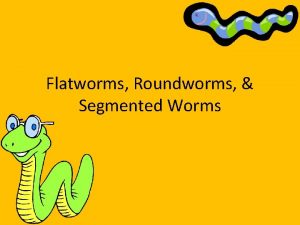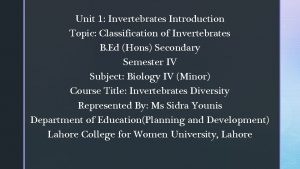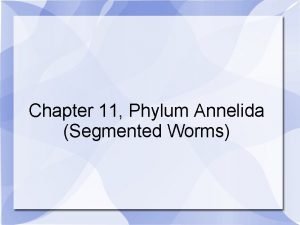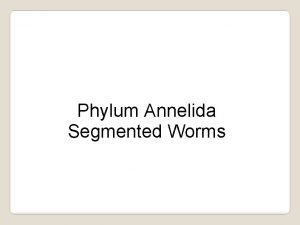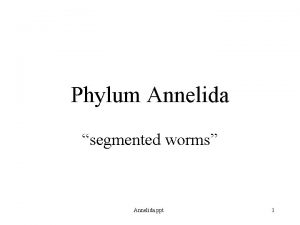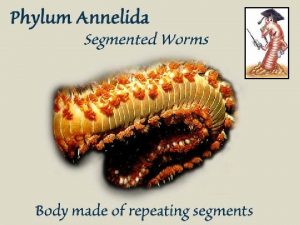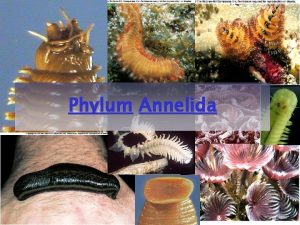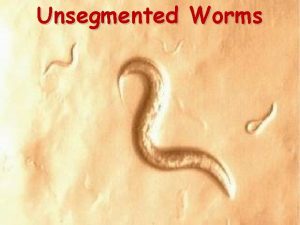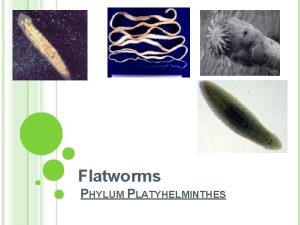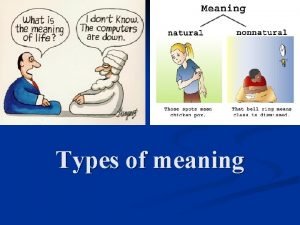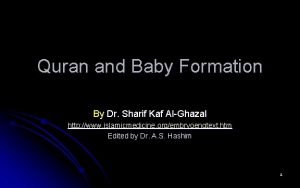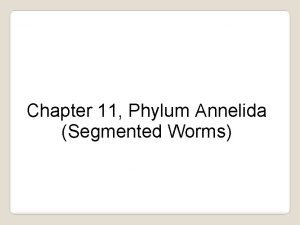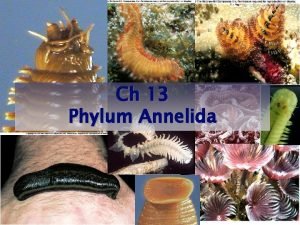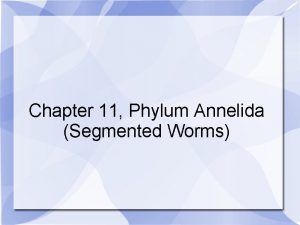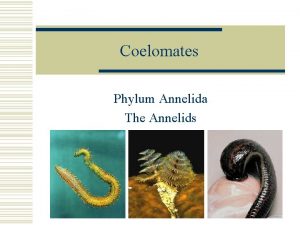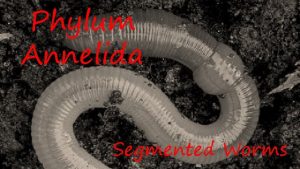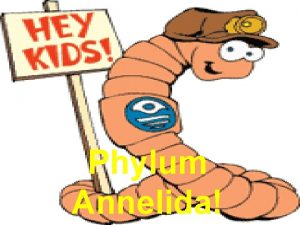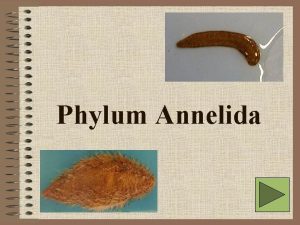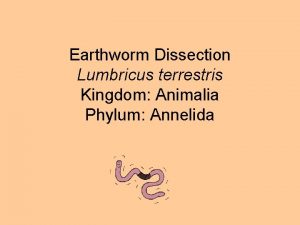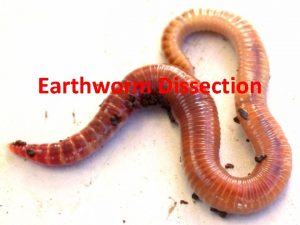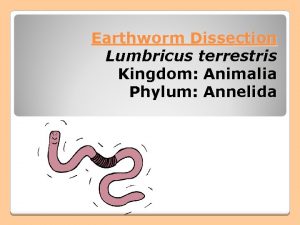Phylum Annelida Leech Earthworm Sandworm Phylum Annelida Learning



















- Slides: 19

Phylum Annelida Leech Earthworm Sandworm

Phylum Annelida – Learning Objectives • • Examine members of the Phylum Annelida and describe their unifying characteristics Describe how annelids carry out their life functions Compare platyhelminthes, nematodes, and annelids with respect to evolutionary changes Describe the ecological roles of platyhelminthes, nematodes, and annelids

Annelids • • • Meaning: Ring Rod Common Name: Segmented Worms Classes: • Polychaeta – sandworms, bristleworms • Oligochaeta – earthworms • Hirudinea - leeches

Body Plan • Coelom – fluid filled mesoderm lined body cavity • Segmented into compartments by septa • Segments marked by rings called annuli • • Bilateral Symmetry 3 Tissue layers • Endoderm • Mesoderm • Ectoderm

Reproduction – Class Polychaeta (sandworms & bristleworms) • • Separate male and female organisms Fertilized eggs can develop into a free swimming, ciliated larvae called trocophores

Reproduction – Class Oligochaeta & Hirudinea (Earthworms and Leeches) • • Sexual reproduction Hermaphroditic with cross – fertilization at the clitellum • Clitellum is a swollen segment which secretes a cocoon that envelopes and protects the eggs when they are laid

Reproduction – Class Oligochaeta & Hirudinea (Earthworms and Leeches) • • Young develop in the cocoon and leave it as fully formed worms NOTE: Earthworms are also able to regenerate segments removed from the ends of the body

Digestion • • Eat leaf fragments, seeds, small animals, and protists Food; • Enters the mouth • Gets pumped through the pharynx • Moves through the esophagus by muscular • • contractions (peristalsis) Enters the crop where it is stored Moves through the gizzard where it gets ground up into tiny pieces Enters the intestine where digestion takes place Undigested food eliminated through the anus

Digestion

Circulatory System Closed circulatory system with two blood vessels that run the length of their bodies • Blood flows from the anterior to posterior end through the VENTRAL blood vessel and returns through the DORSAL blood vessel

Circulatory System • • Five AORTIC ARCHES in the anterior end act as hearts by contracting and forcing the blood into the VENTRAL blood vessel Contraction of the muscles when the earthworm moves helps to move blood through the dorsal vessel back to the aortic arches

Circulatory System • Dorsal & Ventral vessels branch into a network of ring vessels • Ring vessels supply blood to the internal organs • Blood contains; • • Nutrients absorbed from the intestine Gases (O 2 & CO 2)

Respiration • • No structure for respiration: gas exchange takes place across an earthworm’s skin • Tiny vessels carry blood close to the skin’s surface where gases can diffuse into and out of the body The earthworm must stay moist to allow diffusion of gasses across its skin • Have a cuticle to keep water in

Excretion • • Solid waste exits the body via the anus Cellular waste eliminated by nephridia • Have a pair of nephridia (singular: nephridium) in each segment • Nephridium consist of a ciliated funnel that moves waste from body fluids through a long tube to the outside

Excretion

Nervous System • • More advanced brain than unsegmented worms Large ventral nerve cord with many peripheral ganglia (nerve cell bodies) • Ventral nerve cord runs the length of the worm, giving rise to nerves in each segment • Have sense organs that respond to light, touch, sound and chemical substances

Muscular System (Movement) • Two major groups of muscles • Longitudinal • Circular • Circular muscles run in circles around the body of the worm • When they contract they make the worm skinnier • Longitudinal muscles run from the front of the worm to the rear • When they contract they make the worm shorter

Muscular System (Movement) • • They move by squeezing the circular muscles of each segment to make their body extend forward, then they grip the surface with their bristles called setae and contract their longitudinal muscles so their body is pulled up to their anterior (front) end The above process can occur at several places along the body at the same time

Unifying Characteristics of Annelida • • Have a TRUE COELOM (body cavity which allows them to have true organ systems and muscular layers) Posses complex digestive & circulatory systems as well as defined nervous and excretory systems No developed respiratory system as they exchange O 2 and CO 2 via moist epidermis (skin) Are segmented into a sequence of compartments by septa. Segments are marked by rings called annuli Reproduce sexually and some asexually by regeneration and fission Are hermaphroditic with cross fertilization Are found in terrestrial, freshwater and marine environments Can range in size from less than 1 mm to over 3 meters (the seep tube worm)
 Sandworm
Sandworm Earthworm phylum
Earthworm phylum Lumbricus dissection
Lumbricus dissection Earthworm phylum and class
Earthworm phylum and class Earthworm phylum
Earthworm phylum Earthworms belong to the kingdom the phylum
Earthworms belong to the kingdom the phylum Flatworms roundworms and segmented worms
Flatworms roundworms and segmented worms Phylum annelida examples
Phylum annelida examples Annelida
Annelida Phylum annelida
Phylum annelida Earthworm reproduction
Earthworm reproduction Annelida
Annelida Parasitism phylum
Parasitism phylum Phylum annelida
Phylum annelida Phylum annelida
Phylum annelida Flatworm labeled
Flatworm labeled Platyhelminthes
Platyhelminthes Geoffrey leech semantics
Geoffrey leech semantics Leech and embryo
Leech and embryo Leech lake behavioral health
Leech lake behavioral health
